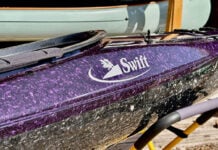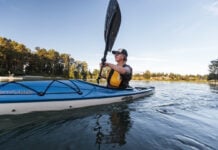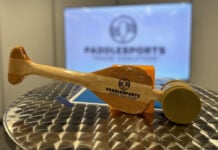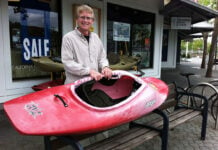Back in 2015, Forest Woodward released a film called The Important Places about floating the Grand Canyon with his father Doug. The title, The Important Places, came from a poem Doug wrote a few days after Forrest was born. It speaks of “The cave behind the waterfall / The arms of the oak that hold you high / The stars so near on a desert ledge” and urges Forest never to lose the path leading back to those important places.
The film was beautifully shot and edited, won the Paddling Film Festival best documentary film award, and at the Outdoor Retailer trade show the river equipment company NRS played it on a loop. For the legions of displaced river rats working the fluorescent-lit catacombs of the Salt Palace, the film served as a reminder of why they started working for outdoor-related businesses in the first place. And when photographer Will Stauffer-Norris asked some of them to write the name of their important place on a dry-erase board and pose for photos, the response was overwhelming.
“People really opened up their hearts,” says Amy Kober, national communications director for American Rivers, which co-sponsored the film with NRS and Chaco. “We were blown away by the stories people shared about the rivers and places they love.”
The modest event showed off the power of personal stories and the ability of brands like NRS to engage large audiences. As the convention hall emptied, Kober and Mark Deming, NRS marketing director, gathered with a handful of colleagues, discussing how to harness this energy toward a bigger issue. This conversation became the seed of the 5,000 Miles of Wild campaign to raise awareness of the Wild and Scenic Rivers Act ahead of its 50th anniversary in 2018.
The three-year campaign collected personal river stories from more than 5,000 people and forged a powerful alliance between river advocacy organizations American Rivers and American Whitewater and industry partners including NRS and OARS. Ultimately, this coalition played a substantial role in the passage of the biggest land use bill in a generation and the Wild and Scenic designation of 676 miles of river. But that’s getting ahead of the story.
When they wear a logo, they want to be sure what it says about them is in-line with how they view themselves
Deming says NRS has always played an active role in conservation, but in the past this meant giving money to organizations like American Rivers and American Whitewater. More recently the company has embraced a more hands-on approach. “We’re really looking to not just kick in money but also contribute our creativity and audience,” Deming says.
That’s been a trend throughout the outdoor industry, as companies recognize the value of publicly advocating for conservation causes. “Millennials are now the largest consumer demographic block in the marketplace, and these consumers really like brands who share their values,” Deming says. “When they wear a logo, they want to be sure what it says about them is in-line with how they view themselves. I’m not saying we’re only doing this because it’s good business, but the data doesn’t lie. It is good for business.”
Stewardship is woven into the company culture at companies such as NRS. George Wendt, the late founder of OARS, became a powerful advocate for wild rivers after witnessing the loss of Glen Canyon and the Stanislaus River to dams.
“It really galvanized his interest in bringing people to see these places to create a deeper appreciation for them,” says Steve Markle, OARS vice president of sales and marketing.
The 5,000 Miles of Wild campaign fit naturally with this philosophy, and OARS spread the word to customers through its network of professional river guides, every one of whom is an influencer with a captive audience. NRS leaned on its talented in-house media team and social media presence to tell compelling river stories and share them with the river running community. Chaco, Keen and Yeti also backed the campaign.
Deming’s role initially was to engage NRS customers in river conservation efforts, but somewhere along the way he ended up lobbying congress.
In September 2018, the Senate allowed the Land and Water Conservation Fund (LWCF) to lapse, despite strong support for the program in both parties. The fund uses revenue from offshore oil and gas leases to support public land protection and infrastructure, and at last count has $22 billion set aside for everything from habitat restoration to boat ramps and municipal parks. At the same time, more than 150 land-use bills were piling up in various congressional dead ends. The midterm elections were over and the powerhouse lobbyists—those working on behalf of pharmaceuticals, insurance and big energy interests—had mostly gone home. Members of Congress were eager to leave too, but the budget impasse over President Trump’s border wall kept them in town. This gave conservation lobbyists and their outdoor industry partners a rare opening.
“We try to do everything we can to be ready for the windows of opportunity when they emerge,” explains American Whitewater Stewardship Director Thomas O’Keefe. He and other conservation lobbyists were already working overtime to save the LWCF. Soon they added the orphaned land-use bills to the conversation, and suddenly the Lands Bill became a thing.
“We just went into offices and acted like this was going to happen,” O’Keefe says. “And when you get enough people saying that, it begins to take on its own momentum. It’s kind of like the Jedi mind trick.”
Outdoor brands played a key role, with Deming among dozens of industry leaders who joined the lobbying effort. Their involvement opened doors in key offices and committees.
“For better or worse, our political system tends to be geared toward jobs and the economy, and companies that are generating economic activity get listened to when they have something to say,” Deming says.
As the land use bill gained momentum, American Rivers, American Whitewater and their paddling industry partners focused on the inclusion of new Wild and Scenic Rivers in the legislation. Thanks in large part to their efforts, the bill added 676 miles to the National Wild and Scenic Rivers System, forever protecting them from new dams and other harmful development.
The protected stretches include 256 miles of the Rogue River and its tributaries in Oregon, 63 miles of the Green River in Utah, desert streams in California and several rivers in New England. The protections are just one part of the sweeping land use bill, which included 170 provisions and the permanent funding of the LWCF. It passed with veto-proof majorities in the House and Senate and was signed into law March 12.
The law will likely buoy the bottom line of outdoor businesses from coast to coast, including NRS, OARS and other brands involved in the campaign. That’s a good feeling, Deming says, but his greatest satisfaction comes from knowing he played a role in protecting the important places.
The Wild and Scenic Rivers Act celebrated its 50th anniversary in 2018.| Photo: Justin Bailie








